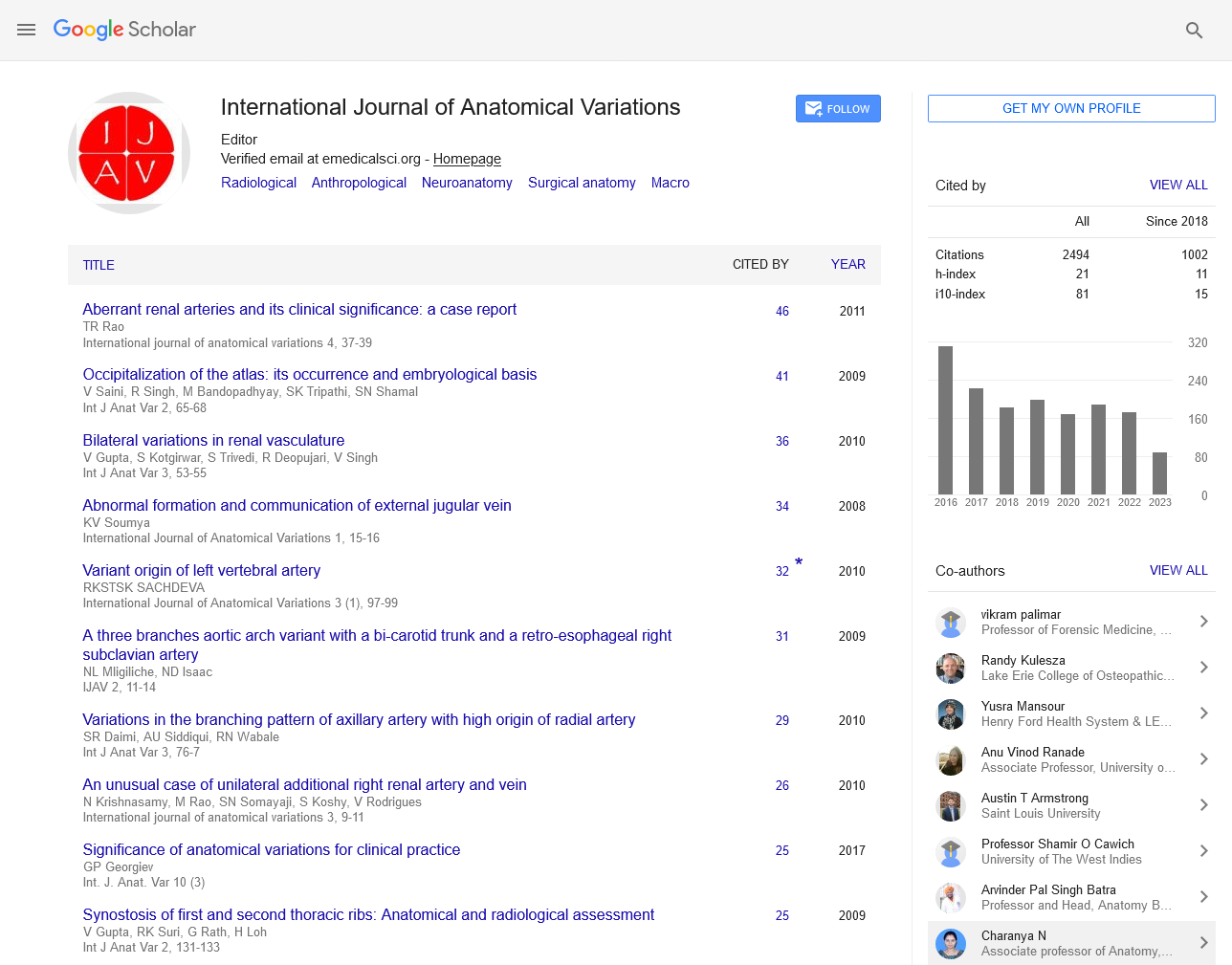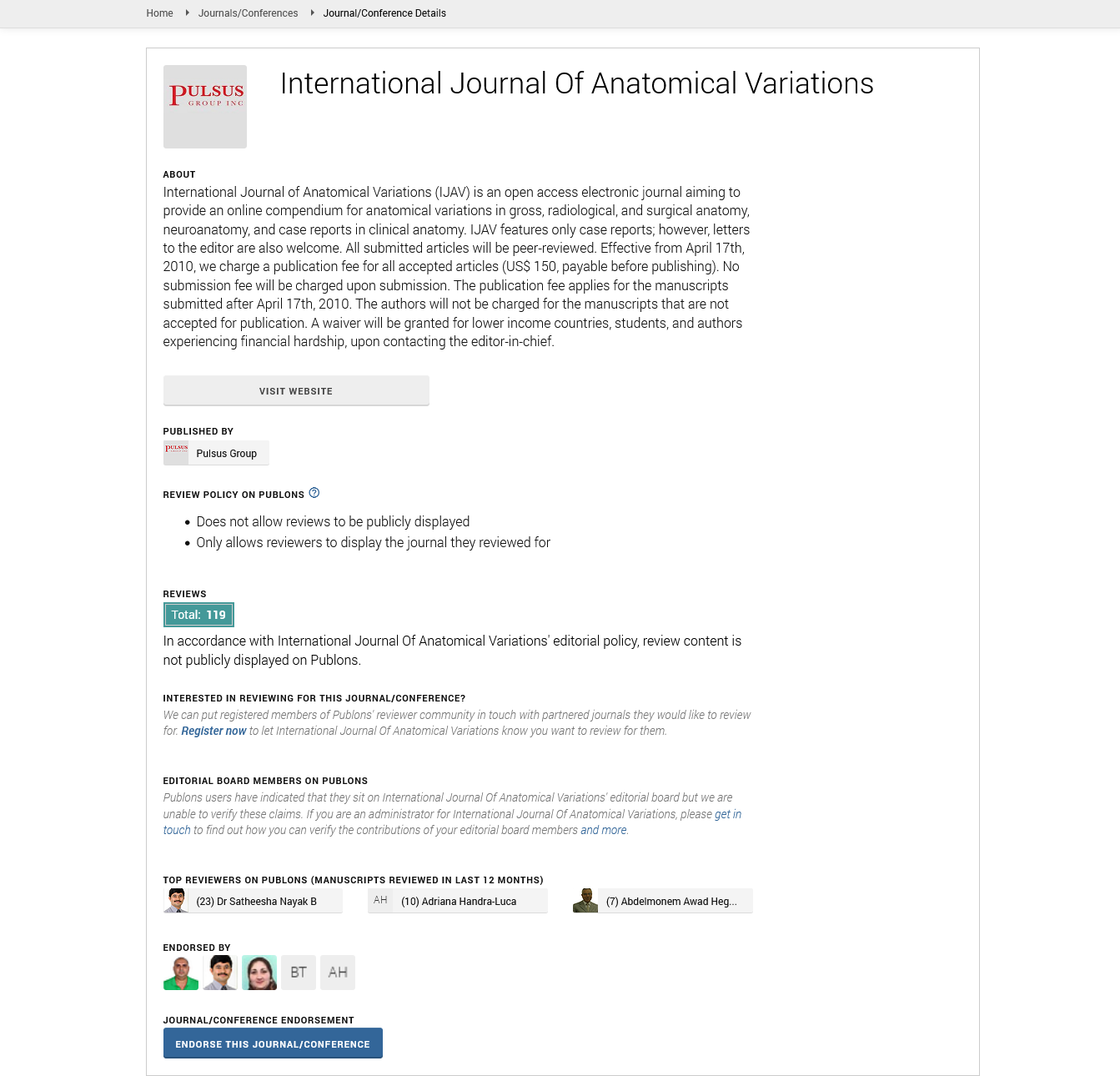Anatomical Variations of the Thoracic Duct: Implications for Lymphatic Surgery and Chylothorax Management
#Equally contribution
Received: 02-Dec-2024, Manuscript No. ijav-24-7356; Editor assigned: 04-Dec-2024, Pre QC No. ijav-24-7356 (PQ); Reviewed: 18-Dec-2024 QC No. ijav-24-7356; Revised: 26-Dec-2024, Manuscript No. ijav-24-7356 (R); Published: 31-Dec-2024, DOI: 10.37532/1308-4038.17(12).463
Citation: Thorne B. Anatomical Variations of the Thoracic Duct Implications for Lymphatic Surgery and Chylothorax Management. Int J Anat Var. 2024;17(12): 695-696.
This open-access article is distributed under the terms of the Creative Commons Attribution Non-Commercial License (CC BY-NC) (http://creativecommons.org/licenses/by-nc/4.0/), which permits reuse, distribution and reproduction of the article, provided that the original work is properly cited and the reuse is restricted to noncommercial purposes. For commercial reuse, contact reprints@pulsus.com
Abstract
The thoracic duct is essential for lymphatic drainage but can exhibit anatomical variations that complicate surgical procedures, particularly in the neck, chest, and abdomen. These variations include multiple origins, additional branches, atypical courses, and bifurcations. Such variations increase the risk of thoracic duct injury and chylothorax, a condition where lymph leaks into the pleural space. This review discusses the clinical implications of these variations in lymphatic surgery, emphasizing the importance of preoperative imaging, precise surgical techniques, and prompt management of chylothorax. Understanding these variations is critical for minimizing complications and improving surgical outcomes.
Keywords
Thoracic duct; Anatomical variations, Chylothorax; Lymphatic surgery; Thoracic duct injury; Lymphatic anomalies
INTRODUCTION
The thoracic duct, the largest lymphatic vessel in the human body, plays a crucial role in the drainage of lymph from the lower body and left side of the head, neck, and thorax. It empties into the venous system, specifically the left subclavian vein. Anatomical variations of the thoracic duct, though relatively rare, can pose significant challenges during surgical procedures, particularly those involving the chest, neck, or abdomen. These variations can also contribute to pathological conditions such as chylothorax, where lymph fluid leaks into the pleural space, leading to serious complications. Understanding these anatomical variations and their implications is essential for improving the outcomes of lymphatic surgeries and the management of chylothorax [1].
THE ANATOMY OF THE THORACIC DUCT
The thoracic duct typically arises from the cisterna chyli, located at the level of the second lumbar vertebra, and ascends through the posterior mediastinum to its termination at the junction of the left subclavian and internal jugular veins. It serves as the conduit for the majority of the body’s lymphatic drainage. It collects lymph from the lower extremities, abdomen, pelvis, and left side of the thorax, head, and neck. The duct typically measures around 5 to 7 mm in diameter but can vary significantly depending on the individual [2].
Anatomical variations of the thoracic duct can occur at various levels along its course, including its origin, path, and termination. These variations may affect the duct’s function and pose challenges during surgical interventions, particularly in procedures involving the neck, chest, and abdominal regions [3].
COMMON ANATOMICAL VARIATIONS
Multiple Origins
In most individuals, the thoracic duct originates from the cisterna chyli, a sac-like structure located at the lower end of the thoracic duct. However, some individuals have multiple cisterna chyli or a direct continuation of the duct from other lymphatic vessels. This variation is relatively rare but has clinical significance, especially during surgeries that require dissection in the retroperitoneal space [4].
Additional Branches
In some cases, the thoracic duct may have additional branches that diverge from the main duct, typically near its junction with the left subclavian vein. These variations are usually asymptomatic but may complicate procedures like central venous catheter insertion or thoracic duct ligation.
Atypical Course
Atypical courses of the thoracic duct are also seen in a subset of individuals. The duct may follow a more medial or lateral course through the posterior mediastinum or may even cross the midline, entering the right side of the neck. These variations can increase the risk of injury during surgeries, particularly those involving the left subclavian vein, aorta, or lymphatic tissue in the chest.
Bifurcation or Trifurcation
In rare cases, the thoracic duct may bifurcate or even trifurcate near its termination, where it drains into the venous system. This variation can complicate procedures such as lymph node dissection, surgery for cancer, or vascular surgeries involving the subclavian or jugular veins.
Absence or Hypoplasia
Some individuals may have an absent or hypoplastic thoracic duct. In these cases, lymphatic drainage from the lower body and left side of the chest may be impaired, and alternative drainage routes may develop. While rare, this anatomical variation can be associated with conditions such as lymphedema and can affect the success of surgeries requiring intact lymphatic drainage [5].
CLINICAL IMPLICATIONS IN LYMPHATIC SURGERY
Anatomical variations in the thoracic duct are of significant clinical importance during lymphatic surgeries. During procedures like lymph node dissection, thoracic duct ligation, or surgery for conditions such as lymphangiomas or lymphatic malformations, knowledge of these variations is crucial for minimizing complications.
Surgical Planning and Approach
Surgeons need to be aware of potential variations in the course of the thoracic duct, particularly when performing dissection in the posterior mediastinum or around the subclavian vein. Injuries to the thoracic duct during these procedures can result in chylothorax, a condition where lymph leaks into the pleural space, causing pleural effusion and respiratory distress. Accurate preoperative imaging, including lymphangiography or advanced imaging techniques like CT and MRI, can help identify variations and guide surgical planning [6].
Thoracic Duct Ligation
In certain cases, such as when managing thoracic duct injuries or preventing chylothorax after surgery, thoracic duct ligation is necessary. However, variations in the duct’s anatomy can complicate this procedure. For example, in cases of bifurcation or multiple branches of the thoracic duct, ligating the wrong branch can fail to stop the lymphatic leakage. Surgeons must identify the main duct and its branches to ensure proper ligation.
Lymphatic Malformations and Lymphangiomas
Lymphatic malformations or lymphangiomas are rare congenital abnormalities that can involve the thoracic duct or its tributaries. Surgical intervention may be required to manage these conditions, particularly when they cause compression of adjacent structures. The presence of anatomical variations in the thoracic duct may complicate resection or drainage procedures, increasing the risk of complications such as chylothorax or lymphatic fluid leakage. [7].
CHYLOTHORAX PATHOPHYSIOLOGY AND MANAGEMENT
Chylothorax is a rare but serious complication resulting from the leakage of lymphatic fluid into the pleural cavity. It is typically caused by trauma to the thoracic duct or its tributaries during surgeries involving the neck, chest, or abdomen. The presence of anatomical variations in the thoracic duct, such as unusual branching patterns or atypical course, increases the risk of unintentional injury to the duct during surgery, which can lead to chylothorax [8].
Etiology of Chylothorax
Chylothorax can result from trauma during surgical procedures, malignancies, congenital malformations, or idiopathic causes. Surgical procedures that pose a risk for chylothorax include lymph node dissections, esophagectomies, thoracic aortic surgeries, and surgeries for malignancies in the head, neck, or chest. Anatomical variations, such as bifurcation or atypical course of the thoracic duct, increase the likelihood of accidental injury during these procedures.
Diagnosis
The diagnosis of chylothorax is confirmed by the presence of chylous fluid in the pleural cavity, which typically appears milky due to the high fat content. This can be detected by analysis of the pleural effusion, where elevated triglyceride levels are indicative of chylothorax. Imaging techniques like CT scans, MRI, and lymphangiography can help identify the underlying cause and anatomical variations in the thoracic duct, allowing for more precise management [9].
Management of Chylothorax
The treatment of chylothorax typically involves conservative measures, such as dietary modification (e.g., low-fat or medium-chain triglyceride diet), drainage of the pleural effusion, and octreotide therapy to reduce lymph production. In cases where conservative treatment fails, surgical intervention may be required to repair the thoracic duct or to ligate the duct at the site of injury. The presence of anatomical variations can complicate the surgical repair, necessitating a more tailored approach based on preoperative imaging findings.
Prognosis and Outcomes
The prognosis of chylothorax largely depends on the underlying cause, the promptness of diagnosis, and the efficacy of treatment. In cases of surgical injury to the thoracic duct, early intervention and repair of the duct can lead to favorable outcomes. However, complications such as chronic chylothorax, respiratory distress, and nutritional deficiencies may arise if the lymphatic leak is not adequately managed [10].
CONCLUSION
Anatomical variations of the thoracic duct are relatively uncommon but have significant clinical implications, particularly during surgeries involving the neck, chest, or abdomen. Understanding these variations is essential for minimizing the risk of complications such as thoracic duct injury and chylothorax. Surgeons should be aware of these variations and incorporate preoperative imaging to guide surgical planning. In cases of chylothorax, prompt diagnosis and management are essential to prevent long-term complications. Further research into the role of anatomical variations in thoracic duct injury and chylothorax management is needed to improve outcomes and refine surgical techniques.
REFERENCES
- Podgórski M, Karauda P, Polguj M. The subscapularis tendon: a proposed classification system. Ann Anat. 2021; 233:151-615.
- Teixeira AR, Leite TFO, Babinski MA. Accessory subscapularis muscle–A forgotten variation?. Morphologie. 2017; 101(333):101-104.
- Christian J. Commentary: Thoracic surgery residency: Not a spectator sport. J Thorac Cardiovasc Surg. 2020 Jun; 159(6):2345-2346.
- Pivin EA, Krakhmaleva DA. Mechanisms of corneal neovascularization and modern options for its suppression. Vestn Oftalmo. 2016; 132(4):81-87.
- Kameda Y. An anomalous muscle (accessory subscapularis teres latissimus muscle) in the axilla penetrating the brachial plexus in man. Acta Anat. 1976; 96:513-533.
- Shigeru H. Glomerular Neovascularization in Nondiabetic Renal Allograft Is Associated with Calcineurin Inhibitor Toxicity. Nephron. 2020; 144 Suppl 1:37-42.
- Konschake M, Olewnik Ł. Unknown variant of the accessory subscapularis muscle?. Anat Sci Int. 97(1), 138-142.
- Youdas JW. Bilateral presence of a variant subscapularis muscle. Int J Anat Var. 2017; 10(4):79-80.
- Janda P, Pękala J, Malinowski K. The subscapularis muscle‐a meta‐analysis of its variations, prevalence, and anatomy. Clin Anat. 2023; 36(3):527-541.
- Jacob SM. Bilateral presence of axillary arch muscle passing through the posterior cord of the brachial plexus. Int. J. Morphol., 27(4):1047-1050, 2009.
Indexed at, Google Scholar, Crossref
Indexed at, Google Scholar, Crossref
Indexed at, Google Scholar, Crossref
Indexed at, Google Scholar, Crossref
Indexed at, Google Scholar, Crossref
Indexed at, Google Scholar, Crossref
Indexed at, Google Scholar, Crossref
Indexed at, Google Scholar, Crossref






